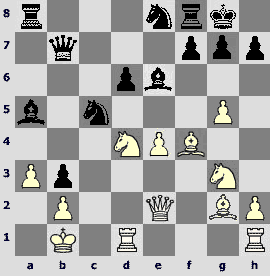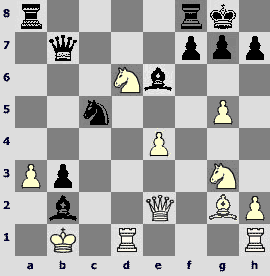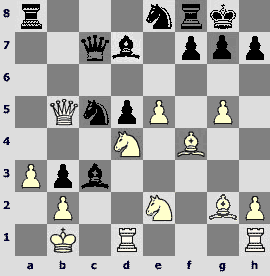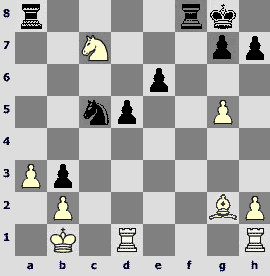13.10.2005
PEARL OF THE DAY №9: A GOOD START THAT ENDED IN NOTHING
In my attempt to strain the tournament situation I considered different options. Morozevich gave serious hope: it is known that when he is in optimal condition, the color does not matter for him, and the last rounds have obviously shown that he managed to throw off a numbness of the first days. Even if Topalov dries the play out, he does not do that cynically, so there would be chances to struggle. There were no doubts Adams playing as White must defeat the leader. Using Fandorin's logic, first of all, Adams has to win at least one game, and secondly the score of his individual encounters with Veselin is in Michael's favor. To build the third reason one can remember the games of this year: Adams had a classic win as White in Wijk aan Zee. In the second half of Sofia, Michael weighed upon the opponent and the game ended in a draw, and in the first half Topalov was lucky to win in a position that is not to be remembered during the world championship – of course, everyone has some resources of luck, but one cannot know exactly when they exhaust. Other ideas were rougher – it will be hard for Svidler as classic chess player to initiate a struggle as Black, but taking Veselin's fighting style and sharpness of the situation into account... Kasimdzhanov gave Topalov a chance to win back here and in Linares, but now his karma is clear, he can start winning...
But all these options presupposed a great introductory step, all the combinations hanging in the air without it. And Vishy did not make this step. He has already forgotten and forgiven the many-hour torture in the first half, gave up on fans thirsting for a spectacle, made a good start that ended in nothing... I would also like to say that Anand chose a wrong scale: he had to sacrifice a pawn and not a piece, and to act like Peter Svidler in the game with Peter Leko in Linares-99. And once he had sacrificed too much, he had to give up materialism and pretend that the pinned f6-knight is not for long in this world, and the a6-bishop is not a human being. And then he had to continue the attack in the firm belief that he had more pieces. There is something wrong in the fact that this game is meanwhile the shortest one in the tournament.
The 2-point gap does not decrease. And still I would not hurry to blow the horn. Let the probability of the Bulgarian grandmaster victory reach 100 per cent, and meanwhile we shall watch.
It is clear that the unblossomed Anand-Topalov bud has nothing to do with the pearls, like the game of the tailenders, Polgar and Adams. They reasonably decided that there is no use to spoil each other's mood, and it is better to wait for more ambitious opponents that can go too far in their impetuosity.
If I started to talk about the third in a row victory of Morozevich with pieces standing on board, I would have to prove that in one positions Sasha was not losing by force, and another position was not bad, and then yes, Black had a sure draw, but White wasn't at risk as well. So, we can state it clear: this was not creative but sporting achievement of the Russian grandmaster. And everything was vice versa in Svidler's game. The yesterday's situation has repeated.
I hope nobody will feel offended if I tell the joke about Czech policemen.
There is a company in a café. One person asks loudly:
– Do you know why policemen always work in pair?
– Why?
– Because one of them can read and the other one can write (burst of laughter).
Two policemen rise from the corner table and approach them. The senior one says:
– We heard you telling the jokes that cast a shadow on... So, you documents, please.
– Here they are.
– (examines the passport for a long time). So, Frantisek, write down.
I do not know why the policemen were exactly Czech, but our policemen have to improve themselves to have such good manners and education...
One more specification is obviously necessary: Peter's opponent was more creative in the best game of the 9th round. However, as the game ended in a draw, we should put one laurel wreath on two heads.
P.SVIDLER-R.KASIMDZHANOV
1.e4 c5 2.¤f3 d6 3.d4 cxd4 4.¤xd4 ¤f6 5.¤c3 a6 6.f3 e5 7.¤b3 Ґe6 8.Ґe3 Ґe7 9.Јd2 0-0 10.0-0-0 ¤bd7 11.g4 b5 12.g5 b4 13.¤e2 ¤e8 14.¤g3 a5 15.ўb1 a4 16.¤c1 Јb8 17.f4 exf4 18.Ґxf4 b3 19.cxb3 axb3 20.a3 Јb7 21.¤ce2 Ґd8. Valery Loginov also made this move in a similar position, but his bishop then was longing to go to the d8-h4 diagonal. Rustam sends his officer to bayonets of the enemy infantry with a quick and elegant movement.
22.¤d4 Ґa5 23.Јe2 ¤c5 24.Ґg2.

24...Ґc3! Let us assess the position passionlessly: White's pieces are harmoniously disposed in the centre, and Black's e8-knight locks the rook, and another rook together with the queen is being X-rayed. The c3-bishop standing en prise prevents us from final verdict «White has a better position». As the bishop is standing like that and one cannot capture it, then there is annoying irrationality in this position. And cannot it really be taken? 25.bxc3 ¦xa3 26.Ґc1 ¦a2 27.¦d2 ¤a4 – no, really not, one will be absolutely routed. It is no use to threaten this cheeky fellow, he is beyond good and evil: 25.¤b5 Ґxb2! 26.Ґxd6 (26.ўxb2 ¤a4+ 27.ўb1 Јxb5) 26...¤xd6 27.¤xd6, and here Black can easily leave the queen attacked –

27...Ґe5! 28.¤xb7 ¦xa3 29.Јb2 Ґxb2 30.ўxb2 (in case of 30.¤xc5? Ґc3 Black finally makes use of his cherished idea) 30...¦a2+ 31.ўb1 ¤xb7, and he has extra pawn and won ending.
The same combinational motif arises in the main computer variation: 25.¤xe6 fxe6 26.Ґxd6 ¤xd6 27.e5 Јa6! (it is important for Black to take control over b5- and c4-squares, and in case of 27...Јa7 White will just take the rook on a8). Now 28.Ґxa8? does not suit because of 28...¤b5! (this move is better than 28...¤c4 29.¦hf1 ¦xa8 30.Јf3, and White captures the bishop) 29.¦hf1 (there is no other defense against ¤xa3+) 29...¦xa8 30.Јf3 Јa7. Opponent's threats are repulsed; Black has a slight material advantage and the attack is soon to be renewed. An attempt of 31.¤f5 (with idea of ¤e7+) is refuted by 31...¤e4! (31...exf5? 32.Јd5+) 32.Јxe4, and now one can play 32...¤xa3+! 33.bxa3 Јxa3 34.¤e7+ ўh8 – White lacks a heavy piece on the f-file. 33...¤c4 leads to victory in case of 33.ўc1.
28.exd6? is also bad:

28...Јxa3! 29.bxa3 ¦xa3 30.Јb2 Ґxb2 31.ўxb2 ¦a2+ 32.ўc3 ¦xg2. As we see, being afraid of the thematic mating threat, White, having an extra queen, inevitably gets the endgame without a pawn. What a sad tendency!
In the position after 27...Јa6! the correct choice is 28.Јxa6 ¦xa6 29.exd6 ¦f2! 30.bxc3 ¤a4 31.¤e4 ¦xg2 32.d7 ¦b2+, but we ran ahead. Or as Johnny in «The Pursuer» said (oh I so much wanted to mention great Argentineans) «I have already played it tomorrow!»
I would like to notice that White could have strengthened the king's position by a modest 25.Ґc1 move, and let us finally see how it was in the game.
25.e5 d5 26.Јb5. At this moment an attempt to press down on the uninvited guest will be met with rudeness – 26.Јe3 Ґxb2! 27.ўxb2 Јa6 28.¦a1 ¤d3+ with consequences unpleasant to White. Black also has strong initiative after 26.¤df5 ¤a4! 27.¦xd5!? Ґxf5+ (an exchange aiming at depriving White's queen of protection) 28.¤xf5 Ґxb2 29.¦d3 Јa6 (reviving the threat of a check from c3) 30.Јf3 ¤c7, and one can assess the position by comparing the kings.
26...Јc7?! Rustam considered this move for a long time, but still did not manage to make the right decision. 26...Јa7! is better. In case of 27.¤c6 we get a known scenario – 27...Јxa3! 28.bxa3 ¦xa3 29.Јxb3 ¦xb3+ 30.ўc2 ¤c7 31.Ґe3 ¦b2+ 32.ўxc3 ¤a4+ 33.ўd3 ¦xg2 34.Ґd4, and White struggles for a draw. The capture of the malicious pawn takes its place a bit late – 27.¤xb3 ¤a4, 27.¤ge2 will be followed by 27...Ґxb2, while 27.Јe2?! lacks consistency in view of the previous move. One will still have to play 28.Јe2 after 27.Ґc1! ¤c7, but here there is a chance to preserve the dignity – «mean intrigues made me go away»...
27.¤ge2. The situation has changed, but bishop is still a sacred piece: 27.bxc3 ¦xa3 28.¤c6 ¦a6! (28...¤a4 29.¦d3 ¦a2 30.Ґc1 is weaker) 29.Јxc5 ¦xc6 30.Јa3 ¦xc3 31.¦c1 Јc4. Knight enters the game – ¤c7-b5, rook follows him, and white king begins to shrivel gradually.
27...Ґd7.

White queen is trapped. It is amazing that 28.¤c6!? will be followed by 28...¦a5! But it is clear that Peter tried to secure himself...
28.e6! Ґxb5 29.Ґxc7 Ґxd4. In case of 29...Ґd3+ 30.¦xd3 ¤xd3 White achieves material and positional advantage by 31.e7 Ґxb2 (31...Ґxd4 32.exf8Ј+ ўxf8 33.Ґxd5 ¦c8 34.¤xd4 ¦xc7 35.Ґxb3) 32.exf8Ј+ ўxf8 33.¦d1 ¤f2 34.¦d2. There is also a stronger continuation 31.Ґg3!
If we run ahead once more, we will see that Rustam's marvelous idea is not universal. In case of 29...¤xc7 30.¤xb5 ¤xb5 31.exf7+ ўxf7 32.Ґxd5+ ўg6 33.Ґxa8 ¦f2 34.¤xc3 ¤xc3+ 35.bxc3 ¤a4 White avoids perpetual check and gets to an endgame with an extra exchange – 36.¦d6+ ўxg5 37.h4+ ўh5 38.Ґf3+ ¦xf3 39.¦d4 ¤xc3+ 40.ўb2.
30.¤xd4. Including 30.exf7+ ¦xf7 31.¤xd4 (31.Ґxd5? Ґxe2) does not bring any advantage. Black does not have to improve his well-being by 31...¤xc7?! (see the next annotation) or 31...Ґd3+ 32.¦xd3 ¤xd3 33.Ґg3 ¦d8 (white pieces' activity promises the compensation for the exchange).The strong 31...Ґc4!? 32.Ґg3 ¤e4 guarantees equality.
30...fxe6! 30...¤xc7 31.¤xb5 ¤xb5 32.exf7+ ¦xf7 33.Ґxd5 is risky, and as it usually happens in such endings, it is hard for knights to play against passed pawns.
30...¤xe6 31.¤xb5 ¤8xc7 32.¤xc7 ¤xc7 33.Ґxd5 ¤xd5 34.¦xd5 leads to a rook ending with equal number of pawns, but not without some problems. Kasimdzhanov solves the position in a clearer and incomparably more spectacular way.
31.¤xb5 ¤xc7 32.¤xc7.

32...¦f2!! 33.¤xa8 ¤a4. The most principled attempt to avoid the perpetual is 34.Ґe4!? dxe4 35.¦d8+ ўf7 36.¦c8 ¦xb2+ 37.ўc1. But after 37...¦a2 it is better for White to forget about the principles and to force a draw by 38.ўb1. The 38.¦e1? b2+! continuation (exactly so, 38...¦a1+ 39.ўd2 b2 40.¦b8 e3+! 41.¦xe3 b1Ј 42.¦xb1 ¦xb1 does not suit Black any more!) 39.ўc2 ¦a1 40.¦b1 e3 transforms the e-pawn into a queen. I will continue the variation suggested by Sergey Shipov: 41.¦c7+ ўg6 42.¦c6 ўf5 43.¤c7 ¦xb1 44.ўxb1 e2 45.¦xe6 ¤c3+ 46.ўxb2 ¤e4, and White has to resign.
Having played 34.¦d3, Peter signed the peace treaty.
Probably, Silvio Danailov had no objections to this result.
